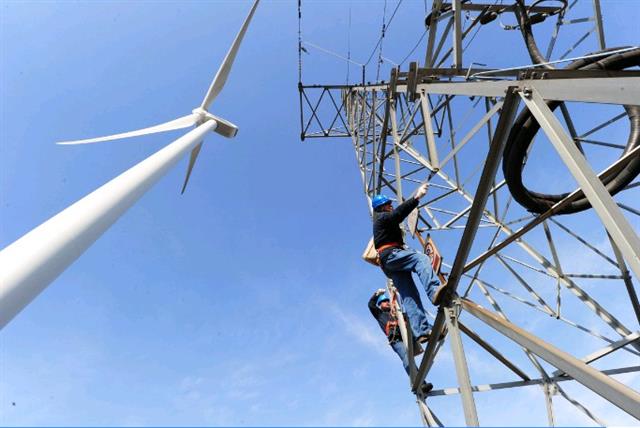China Southern Power Grid, one of the country’s two major power grids, vowed to invest 670 billion yuan ($105 billion) recently in grid network construction during the 14th Five-Year Plan period (2021-25) to ensure power supply stability and boost green power consumption.

Two State Grid technicians check power transmission facilities in Chuzhou, Anhui province. Photo by Song Weixing-For China Daily
The investment will be used on clean energy power transmission, intelligent power distribution systems and smart power consumption, so as to push forward construction of a digital and modern network with new energy as the mainstay, the company said.
The operator’s business covers five areas in the country: Guangdong, Yunnan, Guizhou and Hainan provinces and the Guangxi Zhuang autonomous region.
The planned investment in the grid network during the 14th Five-Year Plan period, which is 33 percent higher compared with the level of the last plan, accounts for 48 percent of the company’s total investment. It also plans to increase its percentage of non-fossil energy power generation to 60 percent by 2025 to around 100 million kilowatts.
State Grid Corp of China, the largest power provider in the country, also pledged to invest 2.23 trillion yuan in the power grid, which means the country’s total grid network investment will soar to 3 trillion yuan during the 2021-25 period.
Both companies vowed to increase power supplies while implementing power price reforms.
Analysts said while the two grid network companies already stepped up the digitalization of grid networks during the 13th Five-Year Plan period (2016-20), the transformation is expected to accelerate during the 2021-25 period. This will in turn not only guarantee sufficient energy supply but also provide more green power in the energy mix of the country.
The investments will lead to a robust grid-network structure and greater use of transmission channels, said Wei Hanyang, a power market analyst at research firm BloombergNEF.
The moves will also help shore up investor confidence in wind and solar projects, Wei said.
The nation’s grid is expected to face an overall tight balance of power with gaps in some areas during the heating season this year, while the country will also face a power-consumption peak, along with the dry season for hydropower.
However, the situation will gradually ease with efforts of the State-owned enterprises, said the National Development and Reform Commission, the nation’s top economic regulator. China’s tight energy supply situation will gradually ease due to the grid network operators’ efforts, it said.
Both companies said power supplies will be stabilized by tapping the potential of all kinds of resources, as the State Council, the country’s Cabinet, recently unveiled a plan to build a new type of power system featuring a gradual increase in the proportion of new energy sources and promoting the large-scale optimization of clean power resources.
Figures released by the two grid operators showed the shares of electricity generated from non-fossil fuels by the two companies have increased during the past three quarters amid government calls to cut coal consumption and increase use of renewable energy in its power mix.
State Grid Corp of China said earlier that its newly grid-connected power capacity generated by new energy has reached 41.74 million kWs during the first three quarters, up 39.1 percent compared with the same period a year ago. The utilization rate reached 97.4 percent, up 0.1 percentage points.
China Southern Power Grid said the five regions that it covers have consumed 540 billion kilowatt-hours of clean energy during the first nine months, with the renewable energy generation efficiency reaching 99.81 percent, up 0.22 percent year-on-year. Newly added installation of new energy reached 3.31 million kWs.
China, which vowed to bring its carbon emissions to a peak by 2030 and reach carbon neutrality by 2060, has pledged to build a new electric power system with the share of new energy resources rising further.
It also pledged to work toward an optimized distribution of clean electricity generation on a broader scale, with the new grid channels to include at least 50 percent of renewable energy and the proportion of coal in interprovincial power delivery to be strictly controlled.


